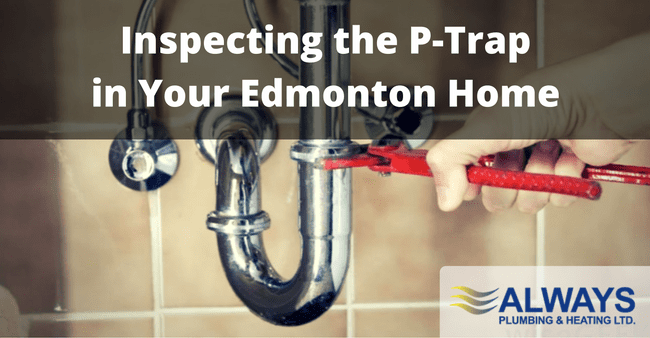A slow drain in your Edmonton home might not be an immediate concern, but if it goes on for too long the stoppage can build up and cause damage. Slow drains in your sink are often the result of issues that can be easily fixed. Before a minor clog turns into a major issue, try tackling the problem yourself. If you have tried using natural drain cleaners (chemical products are bad for your plumbing system), consider inspecting your p-trap to remove the clog. The p-trap is the p-shaped pipe that connects your sink to the wall. A p-trap is designed to “trap” sewer gasses from infiltrating your bathroom – as well as catching debris washed down the sink. The debris is caught in the p-trap, preventing it from moving deeper into your system where it could cause a clog that is harder to reach.
The p-trap is designed to be easily removed and is one of the more simple DIY plumbing procedures.
Removing the P-Trap
Though the removal of the pipe is simple enough, it can be a fairly messy procedure. Be prepared with the following items: rubber gloves, bucket, towels, small cleaning brush and a wrench.
- Remove everything from underneath the sink. The p-trap will contain water and debris, which could be potentially messy.
- Put on your gloves, which will help to grip the pipe – as well as keep your hands clean.
- Place the bucket underneath the p-trap to catch the water and debris that will spill.
- The p-trap is connected by slip nuts on either side, which you should be able to loosen without the aid of a wrench. If the slip nuts are hard to turn by hand, use your wrench to loosen them.
- Once the p-trap is loosened, water and debris will most likely spill into the bucket. Be mindful of fumes while you are relieving the pipe of its contents.
- Use your fingers to remove any debris stuck to the pipe; soap and toothpaste residue is especially sticky. Use your small cleaning brush for especially difficult clogs.
- Run water through the trap (into the bucket) to ensure the entire pipe is clear.
- Reinstall the p-trap to make sure that the clog has been removed.
Proper Plunging
If the clog has not been fixed, try using a plunger. If your sink has a modern stopper, you’ll need to remove it before plunging:
- While you are still situated under the sink, remove the pivot rod that holds in the sink stopper. The pivot rod is the long, horizontal metal piece that connects to the sink. Unscrew the pivot nut and remove the rod.
- Once you’ve removed the rod, pull out the stopper to access the drain.
- Add water to the sink (enough to cover the entire rubber portion of the plunger).
- Place the plunger over the drain and plunge it vigorously for several seconds. Repeat this step a few times if the clog shows signs of movement.
Contact the Edmonton Plumbing Experts
If this second procedure doesn’t fix the clog, you might need to contact a professional plumber to assess the problem. Always Plumbing & Heating can help with any issue you might be experiencing with your plumbing system. If you’re dealing with a clog or other persistent problem that you can’t remedy yourself, give us a call today. Our expert plumbers will have your pipes running smoothly again in no time! Contact us at 780-489-8118 to schedule an appointment.
Related Blogs:

